Fleur-de-Lis Abdominoplasty (Reconstructive surgery) in Newcastle, Maitland & Hunter Valley, Australia
Book Online NowFleur-de-Lis abdominoplasty effectively eliminates excess skin and fat from both the lower and upper abdomen using vertical and horizontal incisions. This approach is ideal for individuals experiencing significant skin laxity following weight loss.
Key Takeaways: Fleur-de-Lis Abdominoplasty
- Ideal for Post-Weight Loss Patients: Fleur-de-Lis abdominoplasty is a highly effective procedure for individuals who have experienced significant weight loss, and both vertical and horizontal skin laxity in the upper and lower abdomen.
- Comprehensive skin removal: Using both vertical and horizontal incisions, the procedure removes excess skin.
- Liposuction (Suction assisted lipectomy) for Excess Fat: If there is a significant amount of adipose tissue (fat) remaining, suction-assisted lipectomy can be added to the procedure to further accomplish the results.
- Performed by Dr. Beldholm: This advanced procedure is performed by Dr. Bernard Beldholm at Maitland Private Hospital.
- Ideal for Patients with Extensive Skin Laxity: For patients with significant skin laxity after weight loss, the Fleur-de-Lis technique offers more extensive results compared to traditional abdominoplasty.
- Long-Term Results: Maintaining a stable weight and a lifestyle rooted in wellness is essential for sustaining the results of this procedure. Significant weight fluctuations can negatively affect the outcome.
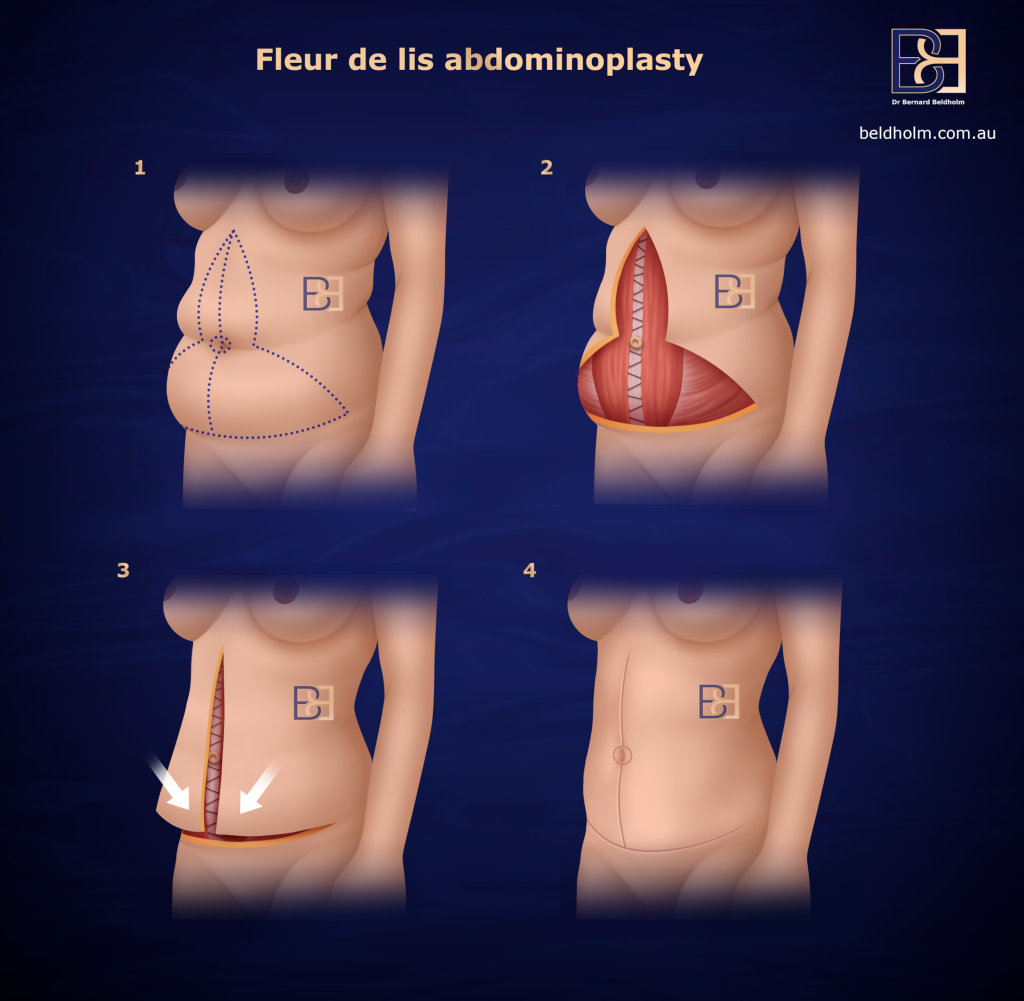
Understanding Fleur-de-Lis Abdominoplasty
Fleur-de-Lis abdominoplasty is an advanced Abdominoplasty procedure that effectively removes excess skin and fat both vertically and horizontally. This makes it particularly well-suited for individuals who have experienced significant weight loss, resulting in skin laxity in both the vertical and horizontal direction. The procedure involves an inverted T-shaped incision across the anterior abdomen, allowing for comprehensive skin removal. In addition to focusing on the waist and abdominal areas, it also targets the mons pubis.
Book Online NowIdeal Candidates for Fleur-de-Lis Abdominoplasty
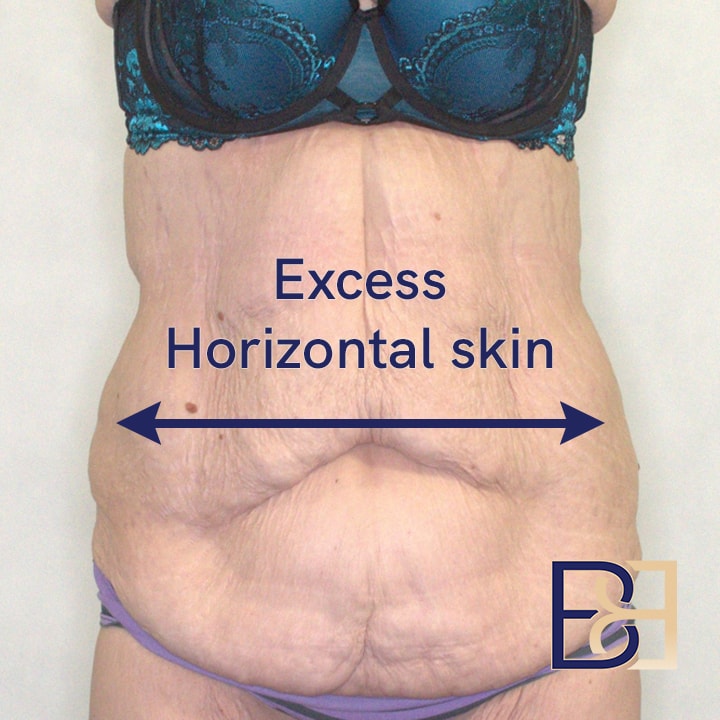
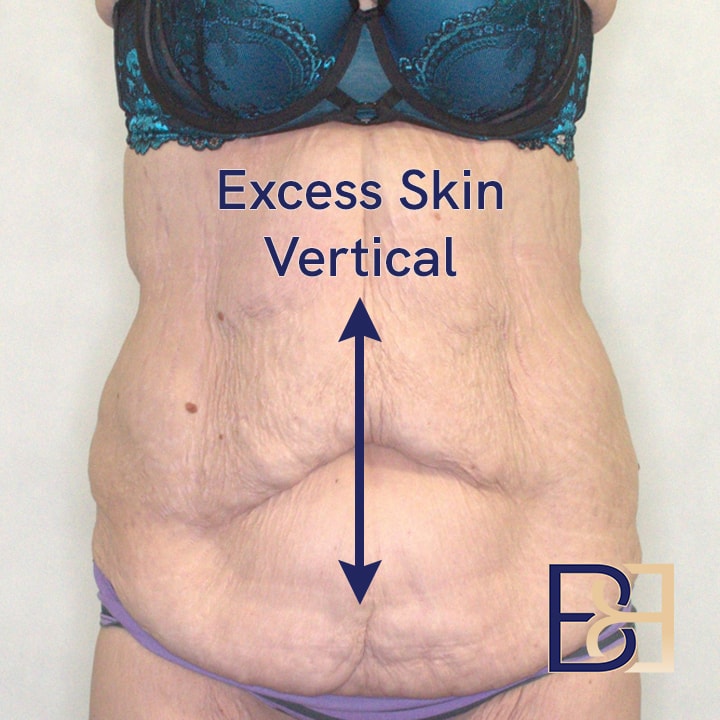
Fleur-de-Lis abdominoplasty is particularly suited for individuals who have experienced significant weight loss. When patients gain a large amount of weight, their bodies often swell. Upon losing this weight, they are left with excess skin, on both the upper and lower abdominal area and surrounding midsection.
Whereas traditional abdominoplasty primarily focuses on the vertical direction of loose skin by pulling it downward, the Fleur-de-Lis technique not only pulls the skin downward but also inward from the waist area, effectively removing skin in both directions for a more comprehensive result.
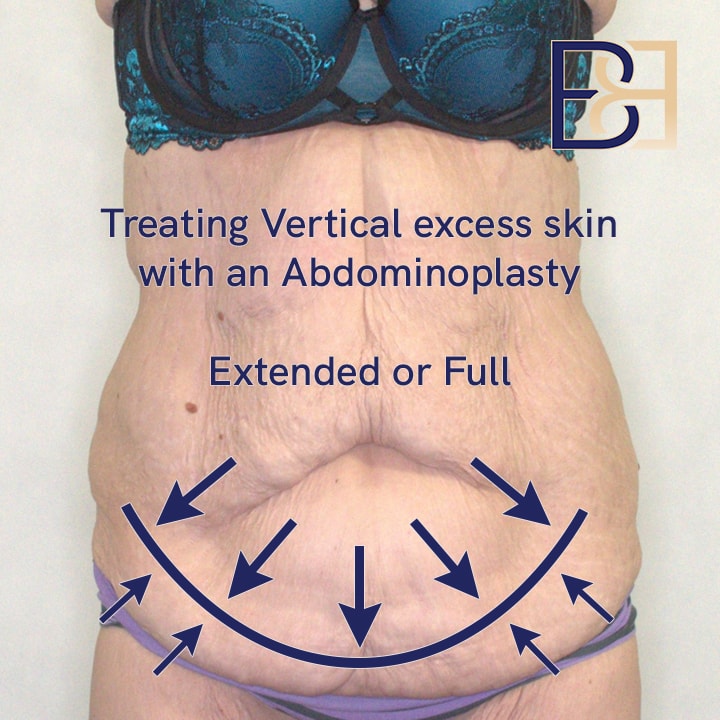
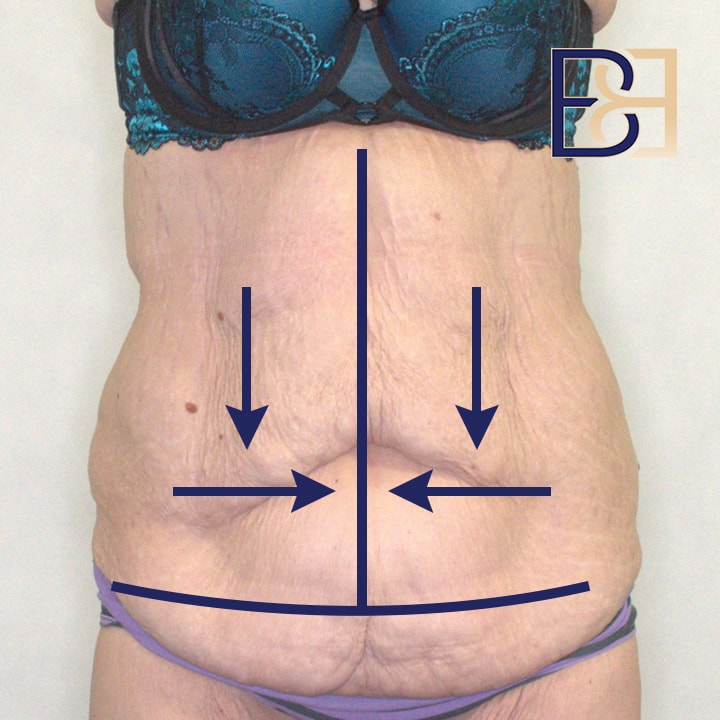
The ideal candidate for this procedure is someone who has excess skin in both the vertical and horizontal directions, typically after significant weight loss or pregnancy.
Candidates should also meet the following criteria:
- Stable Weight: Candidates must maintain a stable weight for at least 6 months prior to surgery. Significant weight fluctuations after the procedure can impact the results.
- Non-Smokers or Willing to Quit: Smoking can hinder the healing process and elevate the risk of complications. Therefore, candidates should either be non-smokers or be prepared to cease smoking well before the surgery.
- Good Health: While overall health is ideal, Dr. Beldholm performs surgeries at Maitland Private Hospital, which has access to an ICU, allowing him to assist patients with more health conditions.
- Fleur-de-Lis Abdominoplasty and BMI: Many post-weight loss patients have reached a BMI within the ideal range, with excess skin being the primary concern. However, some individuals may still have a higher BMI despite losing a significant amount of weight. In these cases, patients can still be good candidates for Fleur-de-Lis abdominoplasty, depending on where the loose skin and fat are located. For patients with a higher BMI, if there is significant excess fat, liposuction can be added to the Fleur de Lis abdominoplasty to remove this fat and further contour the abdomen.
For patients meeting these criteria, the Fleur-de-Lis abdominoplasty offers the option to eradicate excess skin on both the upper and lower abdomen.
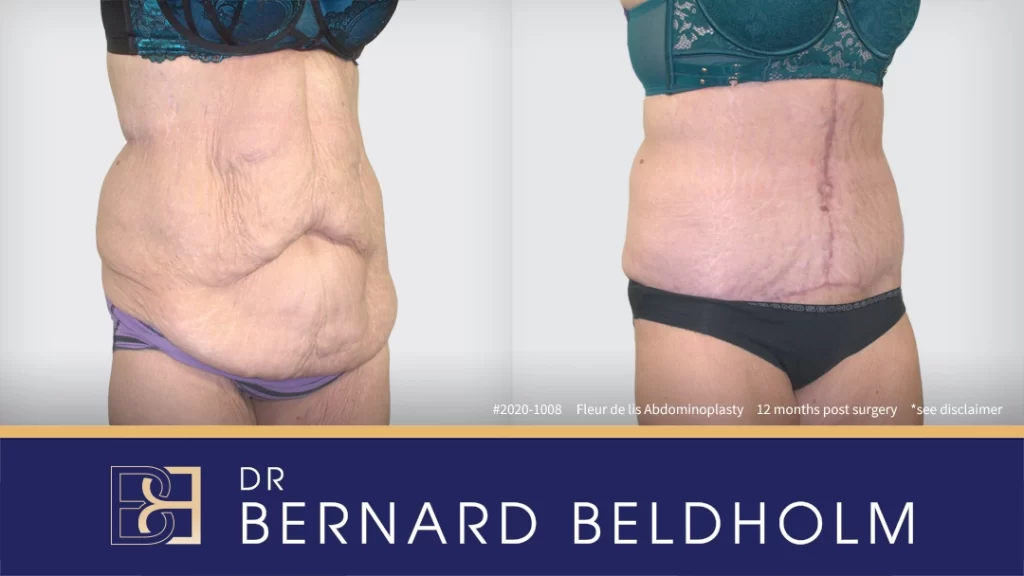
Disclaimer: Operation performed by Dr Bernard Beldholm. Adult content, surgery has risks; individual results vary, seek 2nd opinion. Please see the full disclaimer.
Procedure Overview Fleur-de-Lis Abdominoplasty
The Fleur-de-Lis abdominoplasty is a comprehensive surgical procedure designed to remove excess skin and fat from both the upper and lower abdomen. The procedure involves several steps to ensure optimal aesthetic outcomes and long-term results. Below is an expanded overview of the steps involved in the procedure.
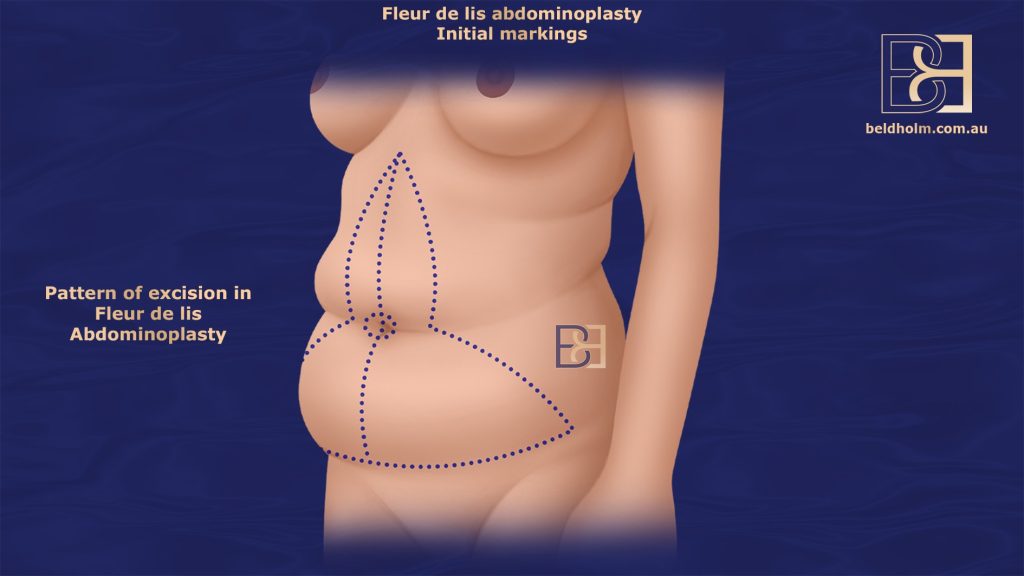
1. Pre-Surgical Markings
Before the surgery begins, Dr. Beldholm takes great care in making the necessary markings on the patient’s abdomen. These markings are done in the anaesthetic bay to ensure they are accurate and guide the surgical process. Proper placement of these markings is crucial for the success of the surgery.
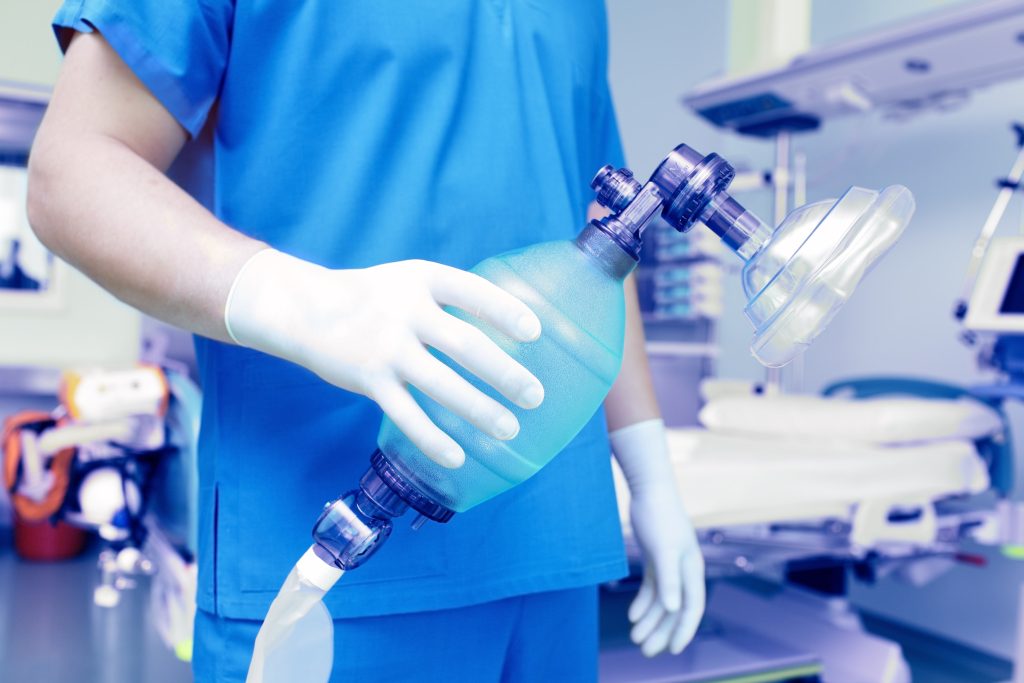
2. Anaesthesia and Patient Positioning
Dr. Beldholm’s anaesthetist administers TIVA (Total Intravenous Anaesthesia), a preferred anaesthetic technique that promotes recovery and reduces the chances of nausea post-surgery. This type of anaesthesia provides a smoother recovery process for patients.
Once anaesthesia is administered, the patient is positioned for optimal access to the abdominal area. The procedure typically takes between 4 to 6 hours, depending on factors such as the amount of loose skin, the patient’s size, and whether any additional procedures, such as liposuction, are required.
3. VASER Suction-Assisted Lipectomy – Optional Step
If Suction-Assisted Lipectomy is necessary, it is performed as the initial step in the procedure. Suction-Assisted Lipectomy is used to remove excess fat. This optional step takes approximately 1.5 hours and is performed in three stages:
- Wetting Solution: A solution is first applied to help loosen the fat and reduce bleeding.
- VASER Suction-Assisted Lipectomy: This technique uses ultrasound to break down fat cells, making them easier to remove.
- Traditional Suction-Assisted Lipectomy: The final step involves the removal of excess fat using suction.
Once the suction-assisted lipectomy is completed, the rest of the surgical procedure continues.
4. Removal of Middle Abdominal Skin
After the suction-assisted lipectomy (if performed), the umbilicus (navel) is carefully separated from the surrounding tissues to ensure it remains properly centred in the final result. Next, the middle abdominal skin is meticulously dissected and removed.
5. Muscle Repair (Diastasis Recti) – Optional Step
If there is diastasis recti, (muscle separation), it can be repaired during this stage of the procedure. Diastasis recti is characterised by the separation of the Rectus abdominis muscles, often resulting from pregnancy or significant weight fluctuations, which weaken the abdominal wall. Repairing the muscle separation helps strength and tone of the abdominal muscles, contributing to a firmer abdomen.
6. Hernia Repair – Optional Step
If hernias are present, they can be repaired as part of the Fleur de Lis abdominoplasty procedure. Types of hernias that can be repaired during the surgery include:
- Inguinal hernia
- Femoral hernia
- Spigelian hernia
- Ventral hernia
- Umbilical hernia
- Epigastric hernia
- Incisional hernia
Repairing hernias during this procedure not only focus on the aesthetic outcome but also the structural integrity of the abdominal wall.
7. Closing the Vertical Incision
Once the excess skin is removed, the vertical incision is closed, ensuring that the abdominal area maintains its new, more defined shape. At this point, the patient is bent at the hips at a 20-30 degree angle to ensure proper skin tension.
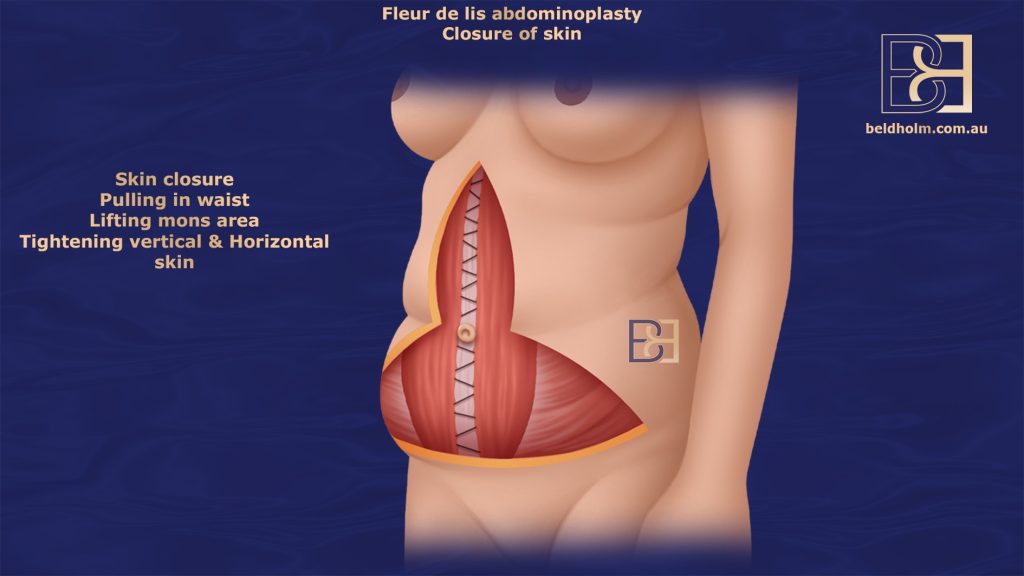
8. Lower Skin Dissection and Umbilicus Management
The next step involves making the lower incision, through which the skin is carefully dissected upward to the level of the umbilicus. This allows for the removal of excess skin from the lower abdomen.
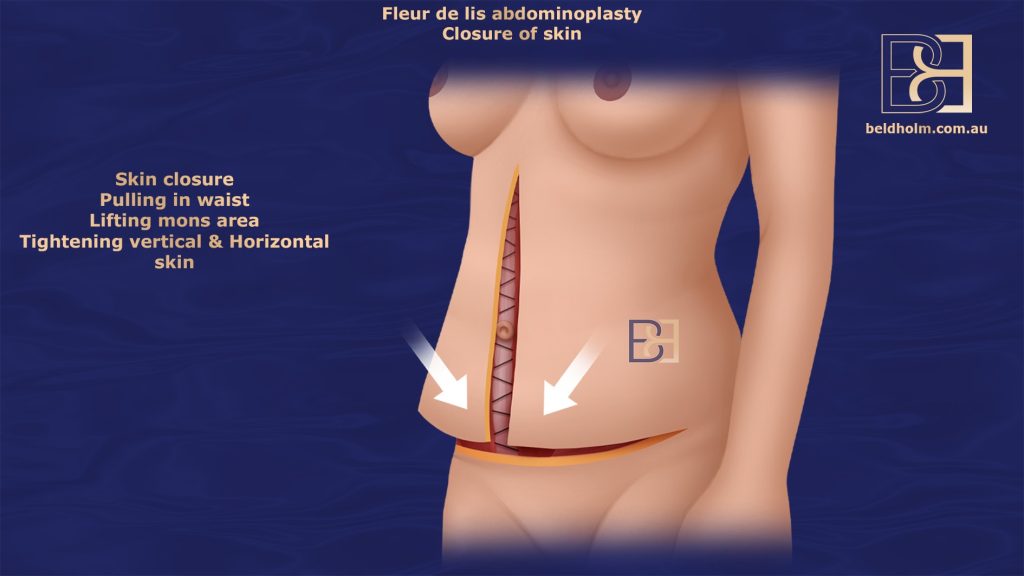
9. Removal of Lower Abdominal Skin
The lower abdominal skin is then dissected and removed in this position, with extra care taken to achieve a smooth, flat appearance. Haemostasis (control of bleeding) is carefully achieved throughout this stage.
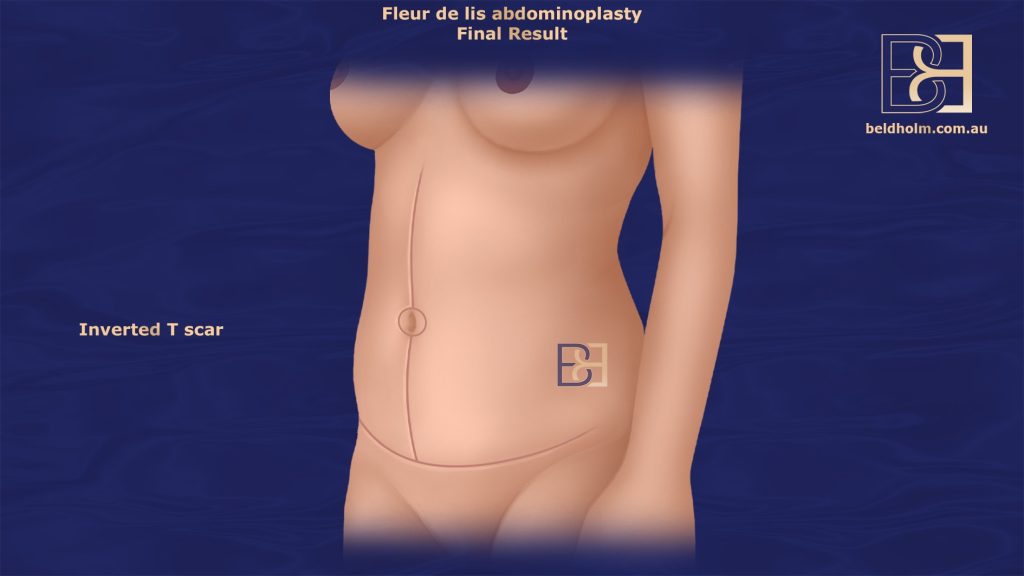
10. Drain Placement and Closure
To assist with the drainage of excess fluids and reduce the risk of complications, two 10F Belovac drains are inserted on each side of the abdomen, exiting from the sides of the hips. These drains are left in place for a period of time after surgery to help with the healing process.
Once the drains are in place, the remaining tissues are closed using absorbable sutures.
11. Application of PICO Dressings and Compression Garments
Finally, PICO dressings are applied to the surgical sites to support healing and minimise scarring. These advanced dressings provide a sterile, moisture-controlled environment that helps promote faster recovery. After the surgical procedure, a compression garment is applied to the abdomen. This garment plays a crucial role in reducing swelling, supporting the abdominal area, and facilitating the healing process.
Comparing Traditional Abdominoplasty and Fleur-de-Lis Abdominoplasty
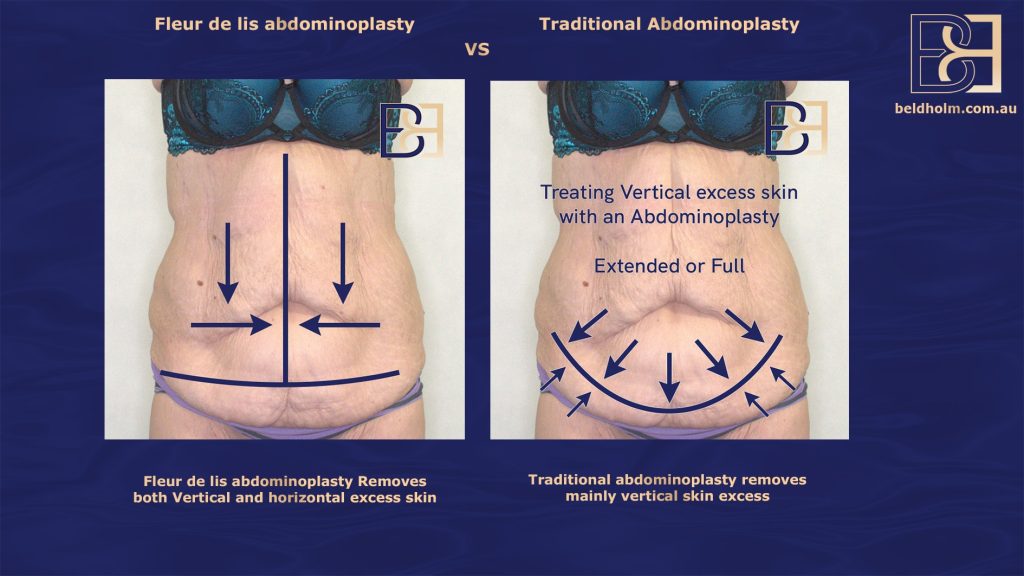
When contemplating an abdominoplasty, it’s crucial to grasp the distinctions between a traditional abdominoplasty and Fleur-de-Lis surgery. Traditional abdominoplasty primarily uses a single horizontal incision to remove excess skin and tighten the abdominal muscles. It may not repair significant skin laxity in the horizontal direction and at the waistline, a common issue for those who have undergone major weight loss.
On the other hand, Fleur-de-Lis abdominoplasty incorporates both horizontal and vertical incisions, allowing for a more comprehensive approach to excess skin removal and body contouring. This difference is particularly crucial for patients with substantial skin laxity.
Incision Differences
The primary incision difference between traditional and Fleur de Lis abdominoplasty lies in the addition of a vertical incision. Traditional abdominoplasty involves a single horizontal incision, which limits the ability to remove excess skin in the horizontal direction. In contrast, the Fleur-de-Lis procedure includes both horizontal and vertical incisions, forming an inverted ‘T’ pattern.
This vertical incision extends from the lower abdomen up to the chest, allowing the surgeon to remove more skin and achieve a tighter. While this results in an additional vertical scar, it provides a significant advantage in focusing on extensive skin laxity.
Skin and Fat Removal Techniques
Fleur-de-Lis abdominoplasty excels in removing both horizontal and vertical excess skin, making it particularly effective for patients who have experienced significant weight loss. Unlike traditional abdominoplasty, which focuses primarily on vertical skin excess, this procedure focuses on the entire abdominal region. Additionally, liposuction (suction-assisted lipectomy) can be incorporated to manage excess fat, further enhancing the contouring and overall results of the procedure.
Disclaimer: Operation performed by Dr Bernard Beldholm. Adult content, surgery has risks; individual results vary, seek 2nd opinion. Please see the full disclaimer.

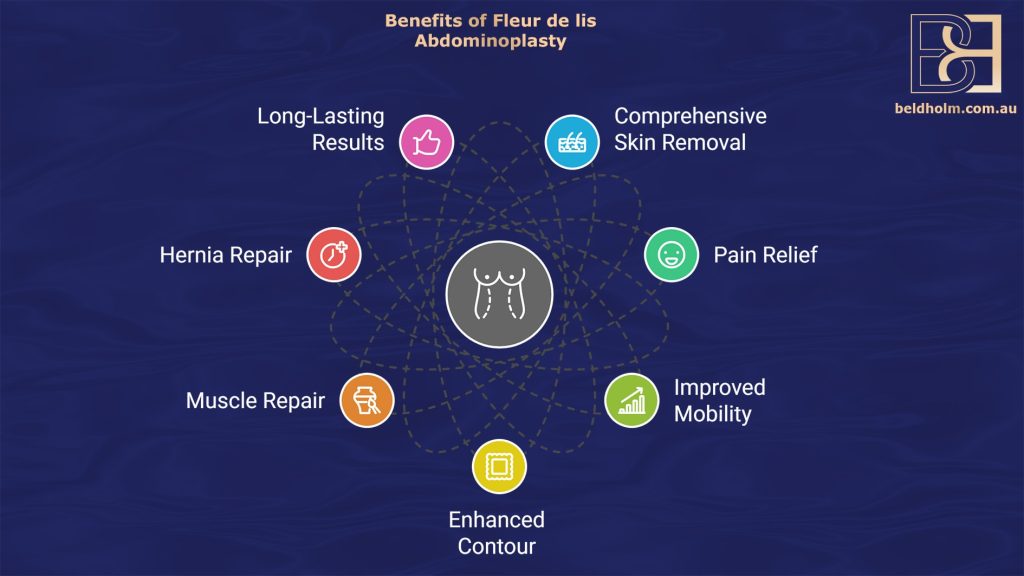
Benefits of Fleur-de-Lis Abdominoplasty
Fleur-de-Lis abdominoplasty provides significant benefits for post-weight loss patients who are left with a large amount of loose skin. For many, this excess skin can cause various physical issues such as rashes, pain, and discomfort. It can also limit daily activities and exercise, making it difficult to maintain an active lifestyle. It offers far more than just aesthetic benefits for these patients.
1. Comprehensive Skin Removal
Fleur-de-Lis abdominoplasty is designed to remove excess skin both vertically and horizontally. This approach is especially beneficial for post-weight loss patients who often experience skin laxity in both the upper and lower abdomen. By focusing on skin in both directions, the procedure provides a more complete solution to the issues caused by loose, excess skin.
2. Relief from Pain and Discomfort
Loose skin often causes physical discomfort, including pain from skin folds rubbing together, rashes, and irritation. Fleur de Lis abdominoplasty helps alleviate these issues by removing excess skin.
3. Improved Mobility and Daily Function
Excess skin can hinder mobility, making it challenging for individuals to perform daily activities or engage in exercise. By eliminating this excess skin, Fleur de Lis abdominoplasty allows patients to regain greater freedom of movement, allowing participation in physical activities and exercise, which is crucial for long-term health.
4. Elevates the Appearance of the Abdomen
While the primary benefit for many patients is physical relief, Fleur-de-Lis abdominoplasty also elevates the appearance of the abdomen. By removing both upper and lower abdominal skin and tightening the muscles, the procedure results in a flatter & firmer abdomen.
5. Muscle Repair (Diastasis Recti)
For many post-weight loss patients, muscle separation (diastasis recti) occurs, weakening the abdominal wall. Fleur de Lis abdominoplasty offers the option of repairing muscle separation, targeting both the functional and aesthetic attributes of the abdomen.
6. Hernia Repair
Patients with loose skin may also suffer from hernias. Fleur de Lis abdominoplasty can repair various types of hernias, including inguinal, femoral, spigelian, ventral, umbilical, epigastric, and incisional hernias, helping to strengthen the integrity of the abdominal wall.
7. Long-Lasting Results
When patients maintain a stable weight and healthy lifestyle, the results of Fleur-de-Lis abdominoplasty can be long-lasting. The procedure provides a more aesthetically pleasing and functional abdominal area for post-weight loss patients.
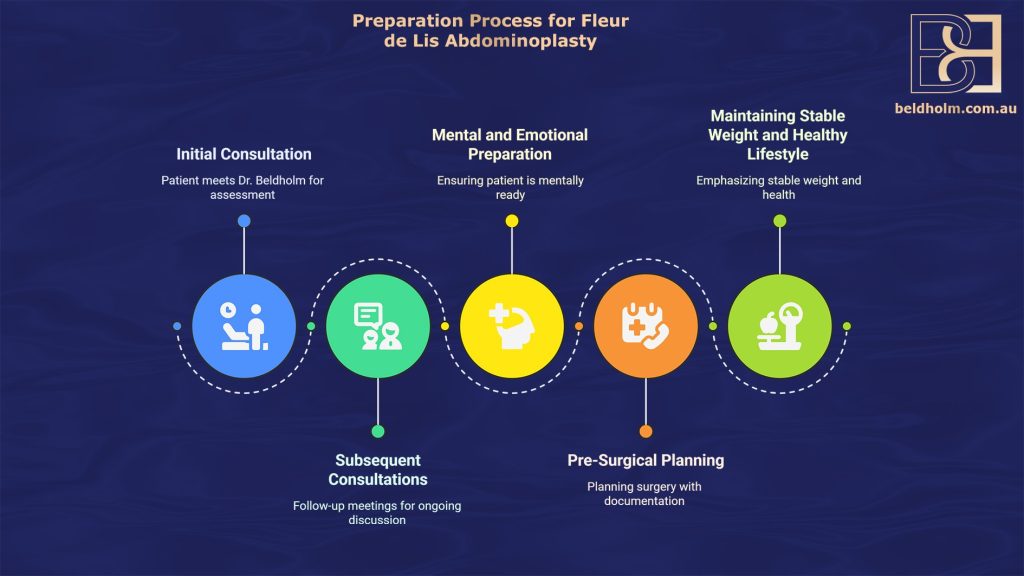
Preparing for Fleur-de-Lis Abdominoplasty
Dr. Beldholm’s preparation process for Fleur-de-Lis abdominoplasty starts with ensuring that patients are physically and mentally ready for the surgery. The most important factor is maintaining a stable weight and a healthy lifestyle, both before and after the procedure. This ensures the best possible results and long-term success.
Book Online Now1. Initial Consultation
The first step in the process is an initial consultation, which is charged. During this meeting, Dr. Beldholm will assess your overall health, discuss your medical history, and understand your surgical goals. It’s crucial to be open and honest about your medical conditions, medications, lifestyle choices, such as smoking and alcohol use, as these can greatly impact the success of the surgery.
2. Subsequent Consultations
After the initial consultation, Dr. Beldholm generally sees patients at least one more time, with these follow-up consultations provided at no additional charge. These visits allow for ongoing discussions about the surgery, answer any new questions, and make sure you feel completely informed.
3. Mental and Emotional Preparation
It’s essential to be mentally prepared for the surgery. Dr. Beldholm will take time to explain the procedure, expected recovery time, and what to expect during the healing process. Being fully informed ensures that you are emotionally prepared for the changes and challenges associated with recovery.
4. Pre-Surgical Planning
During your consultations, Dr. Beldholm will take photographs to document your current condition, which will aid in planning the surgery. He will also discuss post-surgery care and the importance of recovery. Preparing for the changes in your daily routine, including altered sleeping positions, is important during your recovery.
5. Maintaining Stable Weight and Healthy Lifestyle
For the best possible outcome, Dr. Beldholm stresses the importance of maintaining a stable weight and healthy lifestyle before and after surgery. This not only helps in achieving the best results but also ensures that the effects of the surgery are long-lasting. Adhering to these principles will support a smooth recovery.
Recovery Process
The recovery process for Fleur-de-Lis abdominoplasty is generally longer than for traditional abdominoplasty due to the complexity of the surgery. Initial recovery typically spans 2 to 4 weeks, during which time patients may need to take time off work to heal properly.
Managing pain effectively is crucial for an optimal recovery, and patients are usually prescribed pain medications to help with this. Drains are often placed post-surgery to eliminate excess fluid and are removed after a few days.
Proper hydration, rest, and avoiding strenuous activities are essential during the initial recovery phase to support healing.
Book Online NowPotential Risks and Complications
Like any major surgical procedure, Fleur-de-Lis abdominoplasty comes with its own set of potential risks and complications. Common risks include infection and scarring, which can be managed with proper care and follow-up appointments. More severe complications may involve heavy bleeding and nerve damage.
Prolonged pain and a difficult recovery process are also potential issues that patients should be aware of. Understanding these risks allows patients to make an informed decision and take appropriate measures to minimise complications.
Cost and Insurance Coverage
Understanding the financial aspects of Fleur-de-Lis abdominoplasty is crucial for anyone considering this procedure. The cost typically includes the surgeon’s fee, anaesthesia, and hospital fees.
Medicare and private insurance may cover part of the costs in selected cases, particularly when the surgery is deemed medically necessary. Qualifying for Medicare coverage requires patients to prove that the surgery is necessary to repair functional issues, such as pain or infections, and to maintain a stable weight for at least six months after significant weight loss.
Private health insurance generally provides broader coverage compared to Medicare, especially for medically necessary procedures.
Combining Fleur-de-Lis Abdominoplasty with Other Procedures
Combining Fleur-de-Lis abdominoplasty with other procedures can complement the overall aesthetic results. Commonly combined surgeries include suction-assisted lipectomy, thighplasty, and brachioplasty.
Post-Surgery Care Tips
Effective post-surgery care is vital for a smooth recovery and optimal results. Initially, patients can expect significant discomfort, swelling, and tightness in the abdomen. Using a compression garment can help minimise swelling and support the healing abdomen. Rest is crucial during this period; avoiding strenuous activities allows the body to heal more effectively.
Protecting surgical scars from sun exposure is important to prevent hyperpigmentation and aid in healing. A balanced diet rich in nutrients supports healing and helps manage weight, which is crucial for preserving surgery results. Staying hydrated by drinking at least 8-10 glasses of water daily is also essential. Avoiding alcohol and smoking is critical as these can impair healing and increase the risk of complications.
Regular follow-up appointments with Dr Beldholm help monitor recovery progress and catch any potential complications early on.
Long-Term Results and Maintenance
Maintaining the long-term results of fleur-de-Lis abdominoplasty requires a commitment to a stable weight and healthy lifestyle. Significant weight fluctuations can adversely affect the surgery results, making it vital to avoid such changes. Regular physical activity, tailored to recovery progress, contributes to better healing and overall health.
A balanced diet and regular exercise are essential for sustaining the outcomes of the surgery. Patients should also protect the surgical area from sun exposure with sunscreen to maintain skin health and appearance. Promptly handling any post-operative issues can assist in an optimal recovery and lead to better outcomes.
Dr Beldholm’s Final Conclusion
Having performed thousands of body contouring operations, I’ve found that Fleur-de-Lis abdominoplasty is an ideal option for many post-weight loss patients. While the procedure requires a significant incision, the amount of excess skin that can be removed is far greater than with other abdominoplasties. In my experience, most post-weight loss patients are more than willing to accept the additional scar when compared to the discomfort and issues caused by the loose skin.
Book Online NowLearn more about the recovery process following Fleur-de-Lis abdominoplasty
Learn more about the potential complications associated with Fleur-de-Lis abdominoplasty
Learn more about the costs of Fleur-de-Lis abdominoplasty
Frequently Asked Questions
Who are the ideal candidates for a fleur-de-lis abdominoplasty?
The ideal candidates for a fleur-de-lis abdominoplasty are individuals who have lost a significant amount of weight and have excess skin in their midsection, along with a commitment to maintaining a healthy lifestyle.
What does the fleur-de-lis abdominoplasty procedure involve?
The fleur-de-lis abdominoplasty procedure involves tightening the abdominal muscles, repositioning the navel, and making vertical and horizontal incisions to remove excess skin and fat, resulting in an upside-down “T-shaped” scar.
What are some benefits of a fleur-de-lis abdominoplasty?
A fleur-de-lis abdominoplasty provides a more defined waist and hips, flattens the abdomen, removes loose skin, and restores overall mobility. Additionally, it offers relief from rashes and discomfort caused by friction and ill-fitting clothing.
What is the expected recovery time after a fleur-de-lis abdominoplasty?
You can generally expect a recovery time of 2 to 4 weeks after a fleur-de-lis abdominoplasty, allowing adequate time for healing. Prioritising rest during this period will facilitate a smoother recovery process.
What are some risks associated with a fleur-de-lis abdominoplasty?
The risks associated with a fleur-de-lis abdominoplasty include infection, scarring, heavy bleeding, prolonged pain, a challenging recovery process, and the possibility of nerve damage. It is important to discuss these risks with your surgeon before proceeding.
